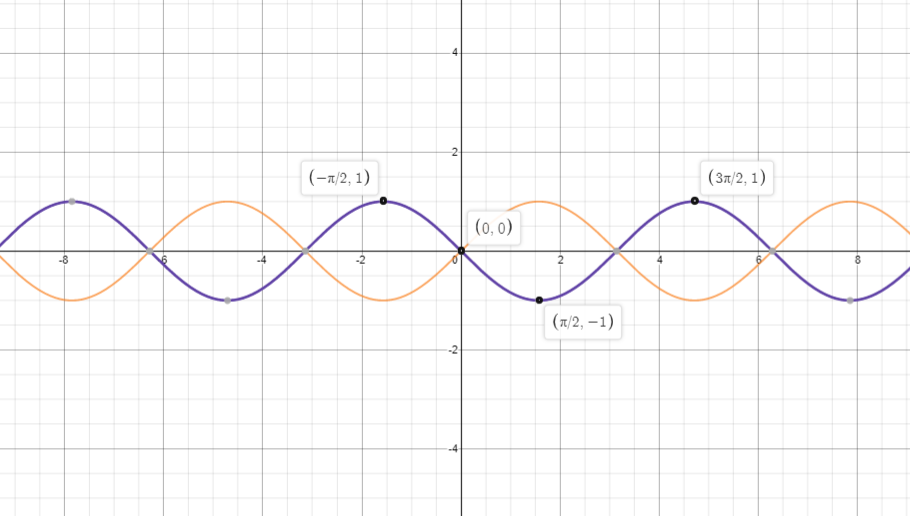
Let f(x) = sgn(x).sin(x), where sgn(x) is the signum of ‘x’. Which of the following is incorrect?
f(x) is continuous everywhere.
f(x) is an even function
f(x) is non-periodic.
f(x) is differentiable for all x except x = 0.
f(x) is non-monotonic.
Answer
530.7k+ views
Hint: In the given question, we have been asked to find the statement which is correct and it is given that\[f\left( x \right)=sgn x.\sin x\]. In order to solve the question, first we know the values of the signum function of x at different intervals. Later we put these values in the given function and find the value of f(x). Then we can infer from the answer that the function f(x) = 0 at x = 0.
Complete step by step answer:
We have given that,
\[f\left( x \right)=sgn x.\sin x\]
As we know that sgn(x) is the signum function of ‘x’.
\[sgn (x)=\left\{ \begin{matrix}
1\ ,x>0 \\
0\ ,x=0 \\
-1\ ,x<0 \\
\end{matrix} \right.\]
Therefore,
Putting the value of sgn(x) in the above given equation;
When x > 0, so sgn(x) = 1
\[f\left( x \right)=sgn x.\sin x=1.\sin x=\sin x\]
When x < 0, so sgn(x) = -1
\[f\left( x \right)=sgn x.\sin x=-1.\sin x=-\sin x\]
When x = 0, so sgn(x) = 0
\[f\left( x \right)=sgn x.\sin x=0.\sin x=0\]
\[f\left( x \right)=\left\{ \begin{matrix}
-\sin x\ ,x<0 \\
0\ ,x=0 \\
\sin x\ ,x>0 \\
\end{matrix} \right.\ \]
Thus,
The function f(x) is continuous for all the values of ‘x’ and we can see below that the graph of the given function is symmetric to y-axis.

Graph is not continuous for the value of x = 0.
Thus the given function is not differentiable at x equal to 0.
Therefore,The option (d) i.e. f(x) is differentiable for all x except x = 0 is the correct answer.
Note: In order to answer the question, students need to know about the concept of the signum function of ‘x’ as otherwise if they didn’t know they would not be able to solve the question. The signum function represents the derivation of the absolute value of function. The range of the signum function is always -1, 1 and 0.
Complete step by step answer:
We have given that,
\[f\left( x \right)=sgn x.\sin x\]
As we know that sgn(x) is the signum function of ‘x’.
\[sgn (x)=\left\{ \begin{matrix}
1\ ,x>0 \\
0\ ,x=0 \\
-1\ ,x<0 \\
\end{matrix} \right.\]
Therefore,
Putting the value of sgn(x) in the above given equation;
When x > 0, so sgn(x) = 1
\[f\left( x \right)=sgn x.\sin x=1.\sin x=\sin x\]
When x < 0, so sgn(x) = -1
\[f\left( x \right)=sgn x.\sin x=-1.\sin x=-\sin x\]
When x = 0, so sgn(x) = 0
\[f\left( x \right)=sgn x.\sin x=0.\sin x=0\]
\[f\left( x \right)=\left\{ \begin{matrix}
-\sin x\ ,x<0 \\
0\ ,x=0 \\
\sin x\ ,x>0 \\
\end{matrix} \right.\ \]
Thus,
The function f(x) is continuous for all the values of ‘x’ and we can see below that the graph of the given function is symmetric to y-axis.

Graph is not continuous for the value of x = 0.
Thus the given function is not differentiable at x equal to 0.
Therefore,The option (d) i.e. f(x) is differentiable for all x except x = 0 is the correct answer.
Note: In order to answer the question, students need to know about the concept of the signum function of ‘x’ as otherwise if they didn’t know they would not be able to solve the question. The signum function represents the derivation of the absolute value of function. The range of the signum function is always -1, 1 and 0.
Recently Updated Pages
Why are manures considered better than fertilizers class 11 biology CBSE

Find the coordinates of the midpoint of the line segment class 11 maths CBSE

Distinguish between static friction limiting friction class 11 physics CBSE

The Chairman of the constituent Assembly was A Jawaharlal class 11 social science CBSE

The first National Commission on Labour NCL submitted class 11 social science CBSE

Number of all subshell of n + l 7 is A 4 B 5 C 6 D class 11 chemistry CBSE

Trending doubts
Differentiate between an exothermic and an endothermic class 11 chemistry CBSE

10 examples of friction in our daily life

One Metric ton is equal to kg A 10000 B 1000 C 100 class 11 physics CBSE

Difference Between Prokaryotic Cells and Eukaryotic Cells

1 Quintal is equal to a 110 kg b 10 kg c 100kg d 1000 class 11 physics CBSE

State the laws of reflection of light




